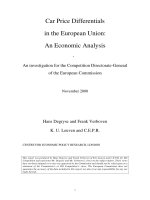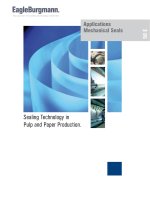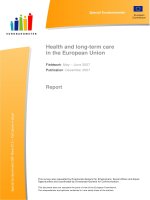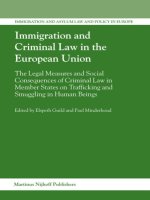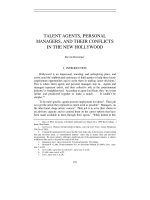WASTE MANAGEMENT FROM PULP AND PAPER PRODUCTION IN THE EUROPEAN UNION doc
Bạn đang xem bản rút gọn của tài liệu. Xem và tải ngay bản đầy đủ của tài liệu tại đây (249.96 KB, 50 trang )
Corresponding author:
Tel.: 34 91 394 42 45
Fax: 34 91 394 42 43
e-mail address:
(M.C. Monte)
1
WASTE MANAGEMENT FROM PULP AND PAPER PRODUCTION IN THE
EUROPEAN UNION
M.C. Monte*, E. Fuente, A. Blanco and C. Negro
Chemical Engineering Department. Complutense University of Madrid.
Avda. Complutense, s/n. 28040 Madrid (Spain)
2
Abstract
Eleven million tonnes of waste are produced yearly by the European pulp and paper
industry, of which 70% originates from the production of deinked recycled paper.
Wastes are very diverse in composition and consist of rejects, different types of sludges
and ashes in mills having on-site incineration treatment. The production of pulp and
paper from virgin pulp generates less waste but the waste has similar properties to waste
from the production of deinked pulp, although with less inorganics. Due to legislation
and increased taxes, landfills are quickly being eliminated as a final destination for
wastes in Europe, and incineration with energy recovery is becoming the main waste
recovery method. Other options such as pyrolysis, gasification, land spreading,
composting and reuse as building material are being applied, although research is still
needed for optimization of the processes. Due to the large volumes of waste generated,
the high moisture content of the waste and the changing waste composition as a result of
process conditions, recovery methods are usually expensive and their environmental
impact is still uncertain. For this reason, it is necessary to continue research on different
applications of wastes, while taking into account the environmental and economical
factors of these waste treatments.
KEYWORDS: Paper industry wastes, pulp and paper sludge, solid waste generation,
waste recovery, waste minimization
3
1. Introduction
Different processes in the pulp and paper industry result in the formation of different
solid wastes and sludge. Solid waste is mainly generated from pulping, deinking unit
operations and wastewater treatment. The amount and the composition of the solid
waste depend on the paper grade produced, the raw materials used, the process
techniques applied and the paper properties to be achieved. The significant residual
waste streams from pulp and paper mills include wastewater treatment sludges, lime
mud, lime slaker grits
1
, green liquor dregs
2
, boiler and furnace ash, scrubber sludges and
wood processing residuals. In terms of volume, most solids or liquids are those from the
treatment of effluents, although waste from wood is also produced in large quantities
(IPPC, 2001; CANMET, 2005).
In general, solid wastes from pulp production and paper mill operations are humid and
contain some organic compounds in the form of wood or recycled paper fibres,
chlorinated organic compounds and pathogens, significant amounts of ash and trace
quantities of heavy metals.
Whereas the solid waste composition from pulp and paper mills is known and constant,
as a result of the current, highly controlled production processes, sludge compositions,
on the other hand, vary widely throughout the industry and are dependent on the type of
operations carried out at the mill. The wastes can be reused and valorised in a safe and
1
“slaker grits”: lime mud that pebbled in the kiln but did not calcine, from chemicals used in Kraft
pulp mills.
2
“dregs”: in general, are defined as the sediments that have settled at the bottom of a liquid. In the
case of pulp mills, these sediments consist of the matter which does not decant in green liquor
clarifier.
4
environmental way, so landfill is strongly being reduced as their final destination. In
fact, in countries such as Germany, Spain and the Netherlands, waste streams cannot go
to landfill sites. In addition, current legislation and increased taxes have resulted in the
research on non-conventional methods for the management or new uses of pulp and
paper industry solid wastes. However, the difficult physical form of these wastes poses
problems in waste handling and disposal, with the biosludge formed during biological
effluent treatment being particularly problematic. These sludges have a low dry solid
content requiring conditioning before they can be properly handled. Such sludges are
usually thickened, and then either burned in a bark-fired boiler together with bark from
wood handling, or used for landfilling. The problems associated with the landfilling of
sludges and other wastes are the large volumes involved and the possibility of
hazardous substances leaking into the environment. The share of residues disposed of in
landfills has constantly decreased in Europe in recent years as shown in Figure 1, in
favour of the use as secondary raw material in other industries and other applications
(e.g. soil improvers, in road construction, land reconstruction applications and for co-
combustion in heat or power generating plants). This justifies the high number of
studies carried out during the last decade focused on the research of alternative waste
treatments, to minimize their possible adverse effects and on new waste applications
such as, for example, road building, the brick industry, forestry and horticulture (Van
Horn, 1997; Hynninen, 1998; Christmas, 2002; Cernec and Zule, 2005).
Through the increased use of recycled paper, the increased application of water
treatment, tightening legislation and increasing costs of landfill, the pulp and paper
industry is forced to put more and more emphasis on waste management.
5
2. Legislation
The basis of the European waste legislation is the Framework Directive on Waste that is
set out in the Council Directives on Waste 75/442/EEC (amended by 91/156/EEC) and
Hazardous Waste 91/689/EEC. The Waste Framework includes two categories of
directives: those setting requirements for the permission and operation of waste disposal
facilities, and those dealing with disposal options for specific types of waste (Figure 2).
In addition to these directives, Regulation 259/93/EEC establishes a system for
controlling the movement of waste within, into and out of the European Union
(Papoulias, 2005). The Framework Directive on Waste will be revised, probably in
2008, in order to modernise, simplify and clarify where necessary, and to reinforce
standards and waste prevention (Speight, 2006).
The directive 75/442/EEC defines waste as “any substance or object which the holder
discards or intends or is required to discard”. Its aim is to force Member States to
encourage the prevention or the reduction of waste and its harmfulness by encouraging
the development of clean technologies, technical product improvements and disposal
techniques. Member States should take the necessary measures to ensure that waste is
disposed of without endangering human health, as well as:
- without posing a risk to water, air, soil and plants and animals,
- without causing nuisance through noise or odours,
- without adversely affecting the countryside or places of special interest.
The EU currently recognises five main principles for waste management:
6
- Waste Management Hierarchy. Waste management strategies must aim to
prevent or reduce the generation of waste and decrease its noxious nature by
developing clean technologies. In addition, efforts must be made in order to
contribute, first to the development and marketing of products designed to have
the smallest possible impact in terms of pollution, if any, and secondly to the
development of appropriate techniques for the final disposal of dangerous
substances contained in waste destined for recovery.
- Where the aforementioned strategies are not possible, or fail to be
environmentally and economically viable at the same time, waste materials
should be reused, recycled or recovered, or used as a source of energy, provided
that these practises improve or, at least, do not significantly decrease the quality
of the final product. As a final option, waste should be safely disposed of, e.g. in
landfill sites (Figure 3).
- Self-Sufficiency at the Community and, if possible, at Member State level.
Member States need to establish, in co-operation with other Member States, an
integrated and adequate network of waste disposal facilities, taking into account
geographical circumstances or the need for specialized installations for certain
types of waste.
- Best Available Techniques Not Entailing Excessive Cost (BATNEEC). Emissions
from installations to the environment should be reduced as much as possible and
in the most economically efficient way.
- Proximity. Wastes should be disposed of as close to the source as possible, by
means of the most appropriated methods and technologies in order to ensure a
high level of environment and public health protection.
7
- Producer Responsibility. Particularly, manufacturers have to be involved in
closing the life cycle of their products, from production and throughout their
useful life, until they finally become waste.
The principles of the waste management strategy in the European Union are
implemented, primarily by EC Directives, regulations and decisions that create binding
legal obligations:
- At the beginning of 2004, the Council and the European Parliament adopted
Directive 2004/12/EC amending Directive 94/62/EC on Packaging and
Packaging Waste. The target of this new Directive is to “harmonise national
measures concerning the management of packaging and packaging waste”. In
addition, it has the dual aim of protecting the environment and, at the same time,
optimising the functioning of the internal market. The limited review foresees
that Member States will need to have reached a minimum recycling rate of 55%
and a minimum recovery rate of 60% by the end of 2008. The overall recovery
target for packaging waste is 60% as a minimum by weight, and the overall
recycling target is 55% as a minimum and 80% as a maximum by weight. Part
of the revision is a proposal of a minimum recycling target of 60% for paper and
board packaging by the end of 2008. It also states that when it comes to used
recycled paper and board packaging, “alternative waste management methods
such as composting and incineration with energy recovery can, for certain
fractions and under certain conditions, be comparable to recycling”.
The paper industry (represented by the Paper Packaging Coordination Group,
PPCG) has expressed several concerns with respect to paper recovery, but they
8
are confident that the minimum recycling target can be met, mainly because the
minimum recycling target is comparable to the industries´ voluntary
commitment to raise the recycling level up to 60%, by 2008, across Europe.
- The objective of the Landfill Directive 1999/31/EC is to prevent or reduce, as far
as possible, the negative effects of waste landfilling on the environment, by
introducing stringent technical requirements for wastes and landfills. For the
paper industry, it significantly limits the landfilling possibilities for
biodegradable wastes. This European Directive imposed a reduction of
biodegradable municipal waste to be landfilled to 75% of the total biodegradable
municipal waste produced in 1995 by the year 2006, to 50% by 2009, and to
35% by 2016.
The Directive does not yet cover site landfills, but the Commission intends to
extend the scope of the Directive as soon as more reliable statistics on industrial
landfills are available.
Several Member States have already implemented waste legislation and imposed
higher taxes to restrict landfilling and encourage the development of more
sustainable waste management practices. As an example, in England, taxes of
₤7/t for active waste (secondary or biological sludge) and ₤2/t for inactive waste
(primary sludge) were imposed in 2002. These values were increased until 2004,
reaching ₤15/t (Kay, 2002; OECD, 2004). For the period 2006-07, the standard
landfill tax rate levied on active wastes was £21/t. The tax increases annually by
at least £3/t to reach a medium to long-term rate of £35/t. The objective is to
9
landfill only 85% of the amount of waste landfilled in 1998 in order to reduce
the amount of industrial and commercial wastes sent to landfill.
- In addition, Directive 86/278/EEC on the protection of the environment, and in
particular of the soil, when sewage sludge is used in agriculture is currently
being amended and a new directive will be enacted. This new proposed
Directive almost completely revises the previous. Its purpose is to regulate the
use of sewage sludge in agriculture in such a way as to prevent harmful effects
on soil, vegetation, animals and humans. The most important new aspect deals
with the introduction of precise requirements for defining the advanced and
conventional treatments, mainly addressed to sludge hygienization and odour
reduction. The proposed values for limits of heavy metals, organic compounds
and dioxins are stricter than in the past and new values for the limits of phosphor
content are also proposed. It seems clear that the limitations imposed by this
new Directive will make it more difficult to use sludge in agriculture and that
considerable investments will be needed to fulfil the new requirements (Kay,
2002; Carpentier, 2002; Spinosa, 2004). On the other hand, a directive on
composting (Biowaste Directive) is expected in the near future, and will set
specifications for waste allowed in composting, the technical criteria to be
fulfilled in the composting process and the quality specifications of the compost.
Currently the Commission is working on six thematic areas, including a strategy
on recycling, soil and the sustainable use of natural resources.
- The Integrated Pollution Prevention & Control Directive (96/61/CE) also
applies to the pulp and paper industry. It lays down measures designed to
10
reduce, or if possible, eliminate emissions to air, water and land. It also includes
measures concerning waste, in order to achieve a high overall level of
environmental protection. It also includes the Best Available Techniques (BAT)
that define the most effective and advanced stages.
- Finally, the objective of the Incineration of Waste Directive (2000/76/EC) is to
prevent or reduce, as much as possible, air, water and soil pollution caused by
the incineration or co-incineration of waste, reducing at the same time the risk to
human health that incineration processes entail. It does not cover:
• Fibrous vegetable waste from virgin pulp production and from the
production of paper from pulp, as long as it is co-incinerated at the place of
production and the heat generated is recovered.
• Wood waste, with the exception of wood waste which may contain
halogenated organic compounds or heavy metals as a result of treatment
with wood preservatives or coating, such as wood waste from construction
and demolition sites.
Black liquor is not mentioned because it is not included in the European Waste
Catalogue and does not need to be excluded since it is part of the production process
(Carpentier, 2002).
3. Waste generation
The main types of solid waste generated in pulp and paper mills are briefly described
below (IPPC, 2001; CANMET, 2005):
11
- From pulp mills:
• Rejects: The rejects from virgin pulps consist of sand, bark and wood
residues from woodhandling, which are undesirable for papermaking.
Rejects typically have a relatively low moisture content, significant heating
values, are easily dewatered and are, generally, burned in the mill’s bark
boiler for energy recovery.
• Green liquor sludge, dregs and lime mud: These are inorganic sludges
separated from the chemical recovery cycle. These sludges are normally
landfilled, after dewatering and drying.
• Wastewater treatment sludge: It comes from two sources: primary sludge
and biological sludge generated in the second clarifier. These sludges are
generally blended together, a polymer added and dewatered together to a
25-40% dry solid content.
• Chemical flocculation sludge: It arises from water treatment and is often
transported to the landfill site due to the high content of inorganic matter
and water.
- From paper mills:
• Rejects: The rejects from recovered paper are impurities and consist of
lumps of fibres, staples and metals from ring binders, sand, glass and
plastics and paper constituents as fillers, sizing agents and other chemicals.
Rejects also have a relatively low moisture content, significant heating
values, are easily dewatered and are, generally, incinerated or disposed of in
landfills.
• Deinking sludge: This residue contains mainly short fibres or fines,
coatings, fillers, ink particles (a potential source of heavy metals), extractive
12
substances and deinking additives. It is normally reused in other industries
(e.g. cement, ceramics), or is incinerated, even though it has a poor heating
value.
• Primary sludge: This sludge is generated in the clarification of process water
by kidney treatments, e.g. dissolved air flotation. The sludge consists of
mostly fines and fillers depending on the recovered paper being processed
and it is relatively easy to dewater. This sludge can be reincorporated into
the process for board industry, but for high grade products can be
incinerated, dumped or, otherwise, mixed with deinking or secondary
sludge.
• Secondary or biological sludge: This sludge is generated in the clarifier of
the biological units of the wastewater treatment, and it is either recycled to
the product (board industry) or thickened, dewatered and then incinerated or
disposed of in landfill. Secondary sludge volumes are lower than those
corresponding to the primary sludge, since most of the heavy, fibrous or
inorganic solids are removed in the primary clarifier.
In general, wastewater treatment sludge constitutes the largest residual waste stream
generated by the pulp and paper industry in terms of volume. Sludge generation rates
vary widely among mills (Lynde-Maas et al., 1997; Reid, 1998; Elliott and Mahmood,
2005; Krigstin and Sain, 2006).
Data on total waste generation are scarcely available as most of the pulp and paper mills
already have processes applied to internally treat the wastes which reduce the solid
waste initially generated. This, for instance, applies to bark residues from debarking,
13
which are incinerated in the bark boiler and, as a result, only ashes remain as waste. The
same can apply to sludge incineration. Some figures on generated waste found in
environmental reports from different European pulp and paper mills are shown in Table
1.
The quantity of waste generated when virgin fibres are used as raw material depends
mainly on the pulping process applied (Table 2). In Europe, 65% of total pulp
production is kraft pulp which produces about 100 kg/Adt of wastes. Semi-chemical and
mechanical processes produce about 60 kg/Adt (IPPC, 2001).
In 2005, the total production of paper in Europe was 99,3 million tonnes which
generated 11 million tonnes of waste, representing about 11% in relation to the total
paper production. The production of recycled paper, during the same period, was 47,3
million tonnes generating 7,7 million tonnes of solid waste (about 70% of total
generated waste in papermaking) which represents 16% of the total production from this
raw material (CEPI, 2006).
The amount of wastes generated in paper mills based on recycled fibre depends on the
quality of recovered paper employed as raw material, and on the effort and expenses
made in preparation of secondary fibres for certain product and process requirements.
The average quantities of waste generated by paper grade are summarized in Table 3.
4. Composition
14
It is difficult to determine the composition of solid wastes from pulp and paper mills
due to its dependence on the process, type and grade of paper products manufactured,
methods used for production of pulp from either virgin or recycled fibres, type and
efficiency of equipment used both in the main process and in wastewater treatment
processes, and specific operating practices. Therefore, the waste composition
corresponding to each kind of process may approximately be as follows.
4.1. Pulping
The solid waste removed from mechanical pulping consists mainly of bark and wood
residues from debarking, washing and screening of chips, primary sludge, ash from
energy production and biological sludge.
The main waste associated with this operation consists of different types of sludge,
mainly fibre, containing primary sludge, and sludge from biological wastewater
treatment. A chemical analysis of primary and secondary or biological sludge from a
mechanical pulp mill is shown in Table 4.
As has been mentioned, the kraft pulping process is the most common pulping process
in Europe. The main solid by-products are lime-mud, green liquor sludge (dredge),
recovery boiler ash, grits, bark, ashes and wastewater treatment sludge. If bark and other
wood residues are not burned for energy recovery, they would represent the major
fraction of the residues (Axegard and Backlund, 2002; Demir et al., 2005; Martins et al.,
2007).
15
Green liquor, lime mud and sludge mainly consist of CaCO
3
. Ash from the recovery
boiler mainly consists of sodium sulphate (approx. 85%) and, to a lesser extent, sodium
carbonate (15%). Most of the recovery boiler fly ash and ESP dust is returned to the
chemical cycle. Around 5 kg/t of these residues is removed to control the sulphur
balance. Bark ash consists mainly of CaO/CaCO
3
and potassium salts. Grits mainly
consist of CaCO
3
.
Green liquor sludge, dredges and lime mud are often mixed and constitute the largest
fraction of the overall solid waste generated in the kraft pulping process. The
composition in such a mixed waste varies widely, containing different amounts of
metals as barium, chromium, copper, lead, nickel or zinc.
The sulphite pulping production is related to the generation of different types of
manufacturing-specific wastes, the majority of which can be further utilised. The wastes
are generated at different stages of the production process namely in the debarking,
chipping, screening and cooking liquor clarification operations, in the maintenance of
the plant and also in the treatment of fresh water and wastewater.
4.2. Papermaking using virgin fibre
The waste generated in a paper mill producing paper from virgin pulp is quite small
compared to recycled paper production and pulp production. Waste from paper
production consists of rejects from stock preparation and sludge from water treatments.
The rejects are normally led to the effluent treatment (IPPC, 2001), but they may also be
directly led to sludge dewatering. Most of the solids will end up in the primary sludge.
16
Sludge from fresh water and wastewater treatments represents, in many mills, the main
source of wastes. Different types of sludge can be distinguished:
- Sludge from chemical pre-treatment of surface water to obtain process water by
means of chemical precipitation/flocculation. This residue is only generated in
those mills using surface water with low quality. In that case, the amount of
sludge can be significant.
- Sludge from primary clarification is generated in most mills. It consists
primarily of fibres, fines and inorganic material in mills that employ fillers in
their products.
- Sludge from biological treatment contains a high proportion of organic material.
This sludge and the sludge from primary clarification represent the bulk of the
wastes when using virgin fibres.
- Sludge from chemical flocculation is generated at mills with tertiary effluent
treatment. This treatment produces a considerable amount of sludge. The
amount of organic/inorganic material in the sludge varies from mill to mill,
depending on the dosage and type of flocculants used.
4.3. Papermaking using recovered paper
The use of recovered paper as raw material presents several economic and
environmental advantages, although many cleaning processes are needed to remove the
contaminants that this feedstock introduces into the papermaking process (Blanco et al.,
2004). Most of the impurities present in recovered paper end up as waste. The major
waste materials are rejects, different types of sludges and ashes when the paper mill has
17
an on-site waste incineration system. Depending on the grades of raw material, process
design, manufactured product and wastewater treatment, different amounts and qualities
of wastes are generated.
The residues can be roughly subdivided in heavy and coarse rejects, light and fine
rejects and sludge. Depending on its origin and nature, sludge again may itself be
subdivided into deinking sludge, sludge from process water clarification in micro
flotation units, and sludge from waste water treatment (primary sludge and secondary
sludge from biological treatment).
Rejects are impurities present in the recovered paper, consisting mainly of lumps of
fibres, staples, metals from ring binders, sand, glass and plastics, and constitute about
6,5% of the purchased recovered paper. Rejects are removed as much as possible in the
earliest stage in the stock preparation section.
In general, the paper sludge contains very high levels of dry solids because it is rich in
fibres and therefore dewaters quite easily. All pulp and paper sludge is a mixture of
cellulose fibre (40 to 60% of dry solids), printing inks and mineral components (40 to
60% dry solids: kaolin, talc, and calcium carbonate). Paper sludge is largely carbon
(around 30% C dry solids) and mineral matter (clay and calcium carbonate, 5 to 25 %
dry solids) with a high C/N ratio (50-200). It has low levels of fertilising elements and a
low metal content (European Commission, 2001).
Deinking sludge mainly contains fines, fillers, coatings, ink particles, extractive
substances and deinking additives. Ink particles are a potential source of heavy metals.
18
However, in general, they have comparable pollutant loads as biological sludge with
slightly higher values of copper and zinc and lower values of BOD. There are relatively
significant variations in the pollutant content of the recovered paper and, consequently,
in the deinking sludge (IPPC, 2001).
The sludge from process water clarification is generated in the fibre recovery process
from white waters and in the physical waste water treatment process. It consists of
mostly fines and fillers (both around 50%) depending on the recovered paper being
processed. Typical composition of sludge is given in Table 5.
Paper industry waste, whether of primary, biological or de-inking origin, is
heterogeneous in nature, ranging from a viscous paste to a solid material. The dry solids
content of the residues can vary from 20 to 60% depending on the degree of dewatering.
Therefore, the wastes have to be handled, usually blended and treated (thickened and
dewatered) to obtain a residue with a high dry solid content.
To summarise, paper mill sludge tends to be highly fibrous. Chemical pulp mill sludge
has a higher content of sulphurous compounds, which originate from the process
chemicals (Na
2
S or H
2
SO
3
and bisulphite ion, HSO
3
-
) specific to chemical pulping.
Bleached pulp mill sludge may contain high levels of chlorinated organic compounds,
originating from bleaching agents (Cl
2
, ClO
2
or NaOCl). Deinking plant sludges,
however, have high ash contents due to a high inorganic filler content in the recovered
paper. In terms of residual moisture content before disposal, bark and other mill rejects
tend to dewater easily and have a high solids content, making them suitable for mass
combustion as hog fuel in the bark boiler. Deinking sludges also typically have a low
19
moisture content due to the large fraction of ash and reject material in the flotation unit
foams. Sludges from primary clarifiers dewater more readily than those of secondary
clarifiers due to the higher concentration of bio-solids and the hydrous material of the
latter.
5. Minimization of waste generation
According to the IPPC, installations must be operated in such a way as to meet six
prime objectives:
- Application of best available techniques (BAT) to prevent pollution.
- No significant pollution.
- Waste minimization and the recovery of unavoidable waste.
- Efficient use of energy.
- Prevention of accidental releases.
- Remediation of the plant site back to its original state after plant closure.
An effective waste minimization program can reduce the costs, liabilities, and
regulatory burdens of hazardous waste management, while potentially enhancing
efficiency, product quality, and community relations (Rouleau and Sasseville, 1996;
Holland, 1997). Waste minimization techniques that can help to reduce the amount of
hazardous waste generated include:
- Production planning and sequencing.
- Process/equipment adjustment or modification.
- Raw material substitution.
- Loss prevention and housekeeping.
20
- Waste segregation and separation.
- Recycling.
Concerning waste hierarchy, many paper mills are challenged with the task of using
high levels of secondary fibre, recovering and “upcycling” the fibre to papermaking
specifications and, at the same time, reducing waste generation. Without recourse to the
selection of virgin or low-contaminated secondary fibre sources, the remaining options
for mills under such constraints include:
- Maximising fibre yield from secondary fibre sources, thereby reducing the
losses of raw material in the effluent.
- Reducing raw material losses with the effluent by “closing up” mill systems.
- Engineering paper which can be recycled without generating waste during
production.
- Upgrade paper finishing techniques to enable increased sludge reuse.
- Adoption of friendly recycling techniques in packaging and printing.
6. Waste recovery
Nowadays there are several waste recovery options. These include thermal processes
such as incineration with energy recovery, pyrolysis, steam reforming, wet oxidation
and supercritical water oxidation; composting; recycling; land reclamation and soil
enhancement; production of mineral fillers for building materials and cement;
production of insulating and fire-resistant materials and other uses (eg. pet litter, barrier
materials, conversion to fuel components, carriers for artificial fertilizers) (Moss and
Kovacs, 1995; Zippel, 2001; Cernec and Zule, 2005; Hamm, 2005; Fytili and
21
Zabaniotou, 2006). However, the wastes, especially sludges from the wastewater
treatment, require further processing before recovery. Sludge from mills typically
requires some form of conditioning, thickening and dewatering to reduce volume prior
to its disposal (Springer, 1993; Kantardjieff et al., 1997; Kerr, 1997). Dewatering,
almost always practised, enables the volume of sludge to be reduced. Dewatering can be
carried out through a variety of processes, some of which are complementary:
centrifugation, band filters, filter presses and screw presses. Deinking or mixed sludge
tends to be drier than primary and biological sludge. Sludge containing a high level of
lignin is easier to dewater than other types of sludge. As mentioned above, the dry
solids content of the sludge can vary from 20 to 60%, depending on the level of
dewatering (European Commission, 2001).
It is evident that the final use of the waste depends on its physico-chemical and
microbiological characteristics. For example, if sludge from papermaking is used as a
raw material
for brick production, given that brick manufacture is restricted to the
warmer months of the year, while paper mills produce all year round, the sludge has to
be stored until further processing.
However, in order to employ the sludge as feedstock
in the manufacture of bricks, it is essential to avoid significant chemical and
microbiological
decomposition of the residue during storage. Several parameters can be
used as indicators to monitor ongoing deterioration processes, among them, solid
content, combustion residue, fibre length distribution, water absorbance, viscosity,
compressibility, chemical composition, microbiological contamination and leaching of
various compounds into water (Cernec and Zule, 2005).
22
The main options for waste recovery are described below in further detail, including
their characteristics. The main factors that drive a mill to choose a particular disposal
option may be attributed to various factors such as local infrastructure, costs,
competition with residues from other industries and local policies.
7. Thermal processes
7.1. Incineration or Combustion
The incineration of residues (both rejects and sludge), combined with power and steam
generation, is one of the most commonly applied disposal methods in Europe. This
technique can be applied to almost all types of sludge, including secondary or biological
sludge. However, due to the high moisture and ash content of most sludges, the
incineration process overall balance can be energy deficient. Fluidised bed boiler
technology provides a means for successful thermal oxidation of high ash, high
moisture wastes, producing process steam and/or electricity and reducing at the same
time the mill’s dependence on costly fossil fuels for steam production. These systems
not only utilize deinking and paper sludges, but also material mined from existing on-
site landfills to mitigate ground water contamination problems. Fluidized bed
combustion is rapidly becoming the ultimate solution for the final disposal of paper mill
wastes (Busbin, 1995; Fitzpatrick and Seiler, 1995; Davis et al., 1995; Albertson, 1999;
Porteous, 2005; Oral et al., 2005).
Table 6 summarizes installations at pulp mills which burn some portion of pulp sludge
(CANMET, 2005).
23
The main achievement of the incineration is the reduction of the amount of material to
be landfilled by about 80-90%. For the final disposal or use of the ashes there are
different options depending on the ash qualities achieved. In some cases ash is simply
landfilled, whereas in others it is used by the building industry or in other added-value
applications. Special attention has to be given to the chlorine content of the rejects due
to potential problems of corrosion and air contamination that chlorine-containing
compounds may cause. Ash rinsing technology constitutes an effective option for the
removal or dilution of chlorine and heavy metals enabling a decrease in the chlorine
concentration to levels lower than those required for the agricultural application of ash
(Matsuto, 1999; IPPC, 2001; Christmas, 2002; Tomita et al., 2006).
The combustion behaviour of several paper mill residues, namely deinking sludge,
rejects from cleaning and screening, or sludge from wastewater treatment is shown in
Figure 4. The graph depicts the relationship between combustible/organic content, ash
content and water content. The area of self-supporting combustion where additional
fuels are not necessary is also indicated (IPPC, 2001).
The incineration of this kind of waste is regulated in Europe by Directive 2000/76/EC
on waste incineration (Waste Incineration Directive), which requires all plants to keep
the incineration at a temperature of at least 850°C for at least two seconds. If hazardous
waste with a content of more than 1% of halogenated organic substances, expressed as
chlorine, is incinerated, the temperature has to be raised to 1100°C for at least two
seconds.
24
The set of values for the limits of incinerator air emissions concern heavy metals,
dioxins and furans, carbon monoxide (CO), dust, total organic carbon (TOC), hydrogen
chloride (HCl), hydrogen fluoride (HF), sulphur dioxide (SO
2
), nitrogen monoxide
(NO) and nitrogen dioxide (NO
2
). As an example, the emission limit value for total
concentration of dioxins and furans is 0,1 ng/m
3
, and for CO, 50 mg/m
3
as a daily
average value.
7.2. Pyrolysis
In the pyrolysis process, also called destructive distillation, the organic waste is heated
in the absence of oxygen to produce a mixture of gaseous and liquid fuels, with a solid
inert residue (mainly carbon).
This technology consists of the breakdown of organic matter between about 400 to
800ºC through the application of indirect heat, in an anaerobic atmosphere, all the while
ensuring a capture of the volatiles. By applying indirect heat to a hyperbaric revolving
retort, the sludge is broken down and fractionated into gases, tars and heavy/light oils.
Long exposure times are required to optimize the production of char (CANMET, 2005).
No oxygen is allowed to enter the retort during the decomposition operation; hence no
“combustion” can take place. This technology is an alternative to incineration and
landfill of paper mill wastewater sludge, although it generally requires a consistent
waste stream such as tyres or plastics to produce a usable fuel product (Fio Rito, 1995;
Frederik et al., 1996; Kay, 2002; Fytili and Zabaniotou, 2006).
25
This technology has been developed for wastes with a high carbon content, such as
wood, petroleum and plastic wastes, but it is not yet sufficiently mature enough for
application for paper sludge. However, some investigations are being carried out by
different European Research Centres, aimed at adapting this technology to paper
process sludge.
7.3. Steam reforming
Steam reforming is based on an innovative pulse combustion technology carried out in a
steam reforming reactor system. Pulse combustion is a phenomenon of combustion-
induced oscillations which are incorporated by design to achieve a high heat release and
more complete combustion. The technology not only offers enhanced heat transfer rate
but also low NO
x
emissions. In addition, operating the steam reformer at a lower
temperature (500-600ºC) minimizes the vaporization of toxic metals which remain in
the char (Durai-Swamy et al., 1991; Aghamohammadi and Durai-Swamy, 1995;
Demirbas, 2007).
This technology is currently used for treatment of sewage sludge, and is still considered
an emerging technology for the treatment of paper sludge.
7.4. Wet oxidation
Wet oxidation can be defined as the process through which organic contaminants, in
liquid or solid form, are extracted into water where they come into contact with an
oxidant under conditions that promote their rapid destruction. The process takes place

